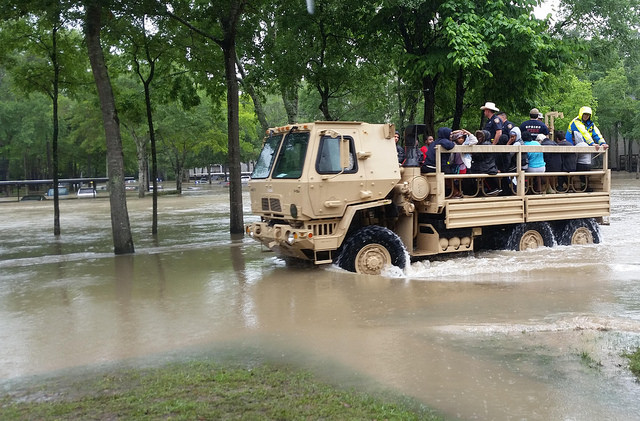
Recent events such as the Flint, Mich., water crisis and extreme flooding in Houston, Texas, have highlighted the dismal state of the nation’s crumbling water infrastructure.

Photo by Texas Military Forces is licensed under CC BY 2.0
Communities everywhere are being forced to face the harsh reality that water must be conserved and antiquated pipelines must be addressed. All this is happening at a time when public funding is simply not adequate to fix the problems.
According to the U.S. Conference of Mayors, maintaining, replacing and upgrading the nation’s water systems through 2028 is likely to cost somewhere between $2.8 trillion to $4.8 trillion. Think the price tag is too high? Maybe not when one considers that there are more than 240,000 water main breaks reported each year and leaking pipes lose more than 7 billion gallons of water every single day in the U.S. Some of the more than 1 million miles of water mains date back to the Civil War era and recent reports show that 44 percent of America’s water infrastructure is considered poor, very poor or life-elapsed.
The Congressional Budget Office reports that the $33 billion spent by state and local governments in 2014 was down 23 percent from the $42.7 billion spent in 2009. Federal grant money has decreased as well. It fell to $3.4 billion in 2014, down 35 percent from $5.3 billion in 2011.Since the needed funding is not available, many cities and communities are turning to private-sector partners to help fund and/or support the work. According to the National Association of Water Companies, more than 2,000 municipalities have already entered into public-private partnerships (PPPs/P3s) to manage all or part of their water supply systems.
Because of critical infrastructure needs (including water infrastructure), the Obama administration established the Build America Investment Initiative. The program was created to incentivize public-private partnerships as a way to finance and manage infrastructure improvements. These partnerships have proved beneficial and access to private capital has allowed municipalities to accelerate the design, construction and operation of water treatment facilities and distribution systems. Public-private partnerships in the water sector have also provided access to a vast national network of water utility professionals as well as to new technologies, economies of scale, innovative methods for efficiency and many new alternative funding sources.
In 2010, the community of Rialto, Calif., benefited from one such partnership. The city’s troubled water system had many issues, including contamination from a shuttered munitions plant and years of deferred maintenance. The city was financially ill-equipped to handle the necessary improvements so officials decided to explore a public-private partnership. Rialto’s efforts resulted in a 30-year concession with a consortium that included a large water firm, a boutique firm specializing in P3s/PPPs and an investment and insurance firm. The reorganized water authority, Rialto Water Services (RWS), agreed to finance the upgrades, manage operations and maintain the system according to the dictates of the city’s officials. The investment of capital will be repaid through revenue-sharing over the term of the contract.
Rialto Water Services compensated the city $30 million up front, extinguished the city’s $27.4 million in utility debt and agreed to invest in a $42 million capital improvement plan for the water system. The partnership essentially shifted all risk as well as operations to RWS during the life of the contract.
Another city in California, Los Angeles, is dealing with water problems that will obviously become critical in the near future. About one-fifth of the city’s water pipes were installed before 1931 and nearly all are approaching the end of their useful lives. The old pipelines are responsible for almost half of all water main leaks, and replacing them is a looming, $1 billion problem for the city.
Public-private partnerships are helping public officials address the nation’s water infrastructure issues. That’s a good thing. Without dependable water resources, a region will perish and with outdated and underfunded water resources, citizens who depend on clean drinking water can also be at risk.
